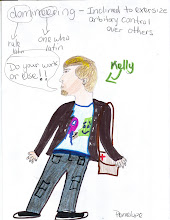Covering
“When She Was Bad,” and “Some Assembly Required,” in which a new year means a
fresh start.
Here’s how I expected the beginning
of season 2 to go: it would start out sort of rough as it shook off some
lingering season 1-ness, it would sometimes find a gear and sometimes slip one,
but then around the time of “School Hard” (which is, like, episode 5 or maybe
7?), around then things would really start humming.
Instead it feels like these two
episodes come roaring off the line popping a wheelstand.
Everything just looks so much
better. Sunnydale High’s halls have, like, a foreground and a background, and
people, lots of people, move between them. Someone figured out how to shoot a
fight, there’s greater effort put into giving them clever little bits, and shadows
and poor lighting (usually) are there to create mood and atmosphere, not to
hide cheapness. The Anointed One’s factory lair is big, and it has levels, and
stuff in it. Even the vampires are more lively! I’m not going to make the
argument that Absalom is a lost gem Buffy baddie, but, you know, his
quasi-revival preacher thing is a whole lot more personality than most previous
minions got. A great deal of what makes these early episodes a real treat is
the sense that amateur hour has been left behind.
We don’t leave the first season
behind entirely, though, as there are a few threads left dangling. It probably
wasn’t terribly important to check in with the Master’s bones (though in genre
shows, it’s always prudent to definitively show someone isn’t coming back, even
if that’s not true), but it was terribly important to check in with how Buffy
processes the events of the finale and the first season as a whole. That she
does so poorly is no big surprise, and if memory serves, there will be plenty
of time to discuss Buffy being, well, a bitch later. Here, at least, there’s
some implied emotional immaturity in her difficulty in coping, and the many forms
that difficulty takes—buying lots of clothes and shoes (Hey! It’s Buffy’s dad
again!), but mostly by being snippy, cruel, and dismissive toward her friends,
potential paramours, and surrogate parental figures, almost daring them to
abandon her. Or perhaps testing them. Point is, her irrationality and
unpleasantness has a rational story basis, with a coherence that makes her even
more likable.
The other dangling threads are
relationships, as Angel and Buffy pull closer together, and Jenny and Giles do
the same, and Cordelia takes on greater, non-joke prominence. But there’s also
the knot of the Buffy-Xander-Willow triangle. I think the only element of
season 1 that was well and truly misguided was Xander’s Buffy crush, or at
least the execution of it. He was just such a clueless jack-ass about it, and
Buffy was so oblivious, he became really hard to take, so much so I really
hoped “Prophecy Girl” would be the end of that story. That wasn’t quite the
case, but at least the show makes a concerted effort to play down Xander’s
behavior to a tolerable level. Trouble is, his Buffy crush colors, and even
dare I say taints his entirely reasonable attitude towards Angel. It’s
impossible to divorce Xander’s distrust of Angel from his instant hatred
towards anyone Buffy showed any interest in.
Just seeing the title “Some Assembly
Required” caused me to fear a second attempt at “I Robot, You Jane,” but this
episode also is a notable step up from the previous season, as it’s a bit of
the usual supernatural hijinks in the high school setting, but significantly
more complicated. It seems at first to be a standard Frankenstein riff, with a
couple of deranged horndog science nerds stitching together their ideal girl
from corpses, until it’s revealed to be a much deeper Frankenstein riff, with a
Creature already animated and begging his creator for a companion. There’s
Chris, a sympathetic modern Prometheus, trapped by his misguided attempt to
repair a family destroyed by an early death, Daryl, the shambling monster
consumed by everything he can no longer be, and Eric, a proto-4chan creepbag
who oddly seems driven more by deranged ambition to create beauty—the perfect
girl isn’t going to be his, after
all. And the ensuing action is marked less by Buffy fighting evil, than by her
appeals to these idiots to stop before they hurt someone and damn themselves.
And Cordelia, in her enhanced role,
is the Damsel in Distress, a role that is increasingly discussed in some
circles lately. BtVS often extends
some small sympathy towards its villains, and while we can’t really call Cordy
a villain when there are vampires and demons and monsters actually walking
around, we can call her an antagonistic presence. Certainly, her archetype, the
Popular Queen Bee, is the villain
oftentimes, and perhaps making that archetype part of a show with far greater
evils was to make the point that there are far worse things in the world than
pretty mean girls in high school. Anyway, there are others out there better
equipped to explicate the gender theory thinking undergirding a pretty girl
imperiled because of her prettiness, but the tensions in Cordelia are
significant, and extend her that sympathy. She’s mocked and reviled for her
superficiality, but desired for the things that superficiality maintains, and
here (this time utterly blamelessly) she nearly becomes a victim of that
desire.
And then she nearly falls into the
hacky fate of so many Damsels by falling for her heroic rescuer. Luckily,
Xander’s jack-assery wipes that cliché off the board.


No comments:
Post a Comment